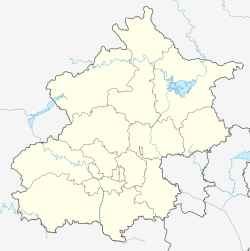Xihuang Temple
Xihuang Temple (simplified Chinese: 西黄寺; traditional Chinese: 西黃寺; pinyin: Xīhuáng Sì) is a Buddhist temple located in Chaoyang District, Beijing.[1]
| Xihuang Temple | |
|---|---|
西黄寺 | |
 A white pagoda at Xihuang Temple. | |
| Religion | |
| Affiliation | Buddhism |
| Deity | Tibetan Buddhism–Gelug |
| Location | |
| Location | Chaoyang District, Beijing |
| Country | China |
 Shown within central Beijing  Xihuang Temple (Beijing) | |
| Geographic coordinates | 39°58′11″N 116°23′49″E |
| Architecture | |
| Style | Chinese architecture |
| Founder | Shunzhi Emperor |
| Date established | 1652 |
History
_-_Google_Art_Project.jpg)
Qing dynasty
In 1644, Shunzhi Emperor established the Qing dynasty (1644–1911) in Beijing. In order to deal with military and political affairs, he invited the 5th Dalai Lama to Beijing in 1651. Shunzhi Emperor issued the decree building the temple as the residence for the 5th Dalai Lama.[2]
In 1780, after the Parinirvana of the 6th Panchen Lama, Qianlong Emperor ordered to built a white pagoda to commemorate him. The construction completed in 1982, Qianlong Emperor named it "Qingjing Huacheng Pagoda" (清净化成塔).[2]
Xihuang Temple was devastated by the combined armies of the English and French during the Second Opium War in 1860. Forty years later in 1900, the Eight-Nation Alliance ransacked Xihuang Temple during the Invasion of Beijing.[2]
In 1908, the 13th Dalai Lama lived here for almost three months.[2]
Republic of China
In 1923, the 9th Panchen Lama came to Beijing and lived in Xihuang Temple.[2][3]
People's Republic of China
After the establishment of the Communist State in 1954, the 10th Panchen Lama and 14th Dalai Lama paid religious homage to Xihuang Temple while they attending the 1st National People's Congress.[2]
In 1979, Xihuang Temple was inscribed to the Beijing Municipal Cultural Preservation Pnit List. The Beijing Municipal Government refurbished and redecorated the temple in the following year.[2]
Xihuang Temple has been designated as a National Key Buddhist Temple in Han Chinese Area by the State Council of China in 1983.
In September 1987, the 10th Panchen Lama set up the High-Level Tibetan Buddhism College of China at the temple.
In 2001, the white pagoda was listed among the "Major National Historical and Cultural Sites in Beijing" by the State Council of China.
On May 18, 2018, the Museum of Xihuang Temple was officially opened to the public.[4]
Architecture
Along the central axis are the Shanmen Hall, Hall of Four Heavenly Kings, Main Hall, Paifang, East Side Hall and West Side Hall.[5]
References
- Tong Xun (1997), p. 253.
- Tong Xun (1997), p. 253–264.
- Shi Miaozhou (2009), p. 264.
- Xu Na (2018-05-24). 回溯藏传佛教历史源流 西黄寺博物馆开馆大展等你来. tibet.cn (in Chinese).
- 西黄寺:禅意隐匿于闹市(图). 163.com (in Chinese). 2011-06-02.
Bibliography
- Tong Xun (1997). 《佛教与北京寺庙文化》 [Buddhism and Culture of Beijing Buddhist Temples] (in Chinese). Beijing: Minzu University of China Press. ISBN 9787810560634.CS1 maint: ref=harv (link)
- Shi Miaozhou (2009). 《蒙藏佛教史》 [History of Buddhism in Mongolia and Tibet] (in Chinese). Suzhou, Jiangsu: Guangling Publishing House. ISBN 9787806942987.CS1 maint: ref=harv (link)